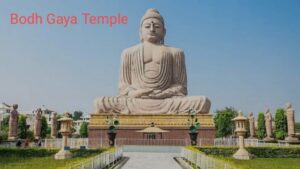Bodh Gaya Temple, a small town in the Indian state of Bihar, is one of the most significant and revered sites in Buddhism. Known as the place where Siddhartha Gautama attained enlightenment and became the Buddha, it attracts millions of pilgrims and tourists each year. This blog post delves into the rich history, architectural splendor, and profound spiritual significance of the Bodh Gaya Temple.

1. Bodh Gaya Temple:Historical Background
The history of Bodh Gaya is intertwined with the life of Siddhartha Gautama, who meditated under the Bodhi Tree until he achieved enlightenment around 2,500 years ago. The site gained prominence under the rule of Emperor Ashoka in the 3rd century BCE, who visited Bodh Gaya and constructed a shrine to commemorate Buddha’s enlightenment. Over the centuries, the site has been embellished with numerous stupas, monasteries, and temples, making it a focal point of Buddhist worship.
2.Bodh Gaya Temple: Architectural Highlights
The Mahabodhi Temple, the centerpiece of Bodh Gaya, is a stunning example of ancient Indian architecture. The temple’s towering stupa, standing at approximately 55 meters, is adorned with intricate carvings and designs. The main sanctum houses a large gilded statue of the Buddha in a seated posture, symbolizing his moment of enlightenment. Surrounding the temple are several smaller stupas, meditation spots, and the sacred Bodhi Tree, a direct descendant of the original tree under which Buddha meditated.

3.Bodh Gaya Temple: Religious Significance
Bodh Gaya is not just an architectural marvel but a site of immense religious importance. Pilgrims from all over the world visit to meditate, offer prayers, and seek spiritual solace. The temple complex hosts several annual events, including the Buddha Jayanti, which celebrates Buddha’s birth, enlightenment, and death, attracting thousands of devotees. Stories and legends about Buddha’s time in Bodh Gaya further enrich the spiritual atmosphere of the site.
4. UNESCO World Heritage Site
In 2002, the Mahabodhi Temple complex was declared a UNESCO World Heritage Site, recognizing its outstanding cultural and historical value. The site met several UNESCO criteria, including its association with the enlightenment of Buddha and its architectural and artistic significance. Being a World Heritage Site has brought increased global attention, funding for preservation, and heightened efforts to maintain its sanctity and integrity.
5. Visiting Bodh Gaya
The best time to visit Bodh Gaya is between October and March, when the weather is pleasant and conducive to exploring. Bodh Gaya is well-connected by air, rail, and road, with the nearest airport being Gaya Airport, about 17 kilometers away. Numerous accommodation options range from budget-friendly guesthouses to luxurious hotels, catering to the diverse needs of visitors.
6. Local Culture and Surroundings
Visitors to Bodh Gaya can immerse themselves in the local culture, which is deeply influenced by Buddhist traditions. Nearby attractions include the Great Buddha Statue, a 25 meter-high statue depicting the Buddha in meditation, and the Tibetan Monastery, which offers a glimpse into Tibetan Buddhist practices. The local cuisine, a blend of Bihari and Buddhist influences, offers a unique gastronomic experience with dishes like litti chokha, sattu paratha, and Tibetan momos.
7. Preservation Efforts
Preserving Bodh Gaya’s heritage involves continuous conservation and restoration initiatives. The Archaeological Survey of India, along with international organizations, plays a crucial role in maintaining the site’s structural and historical integrity. Challenges such as environmental degradation and the impact of tourism are addressed through sustainable practices and community engagement.
8. Personal Experience and Reflections
Visitors often share profound experiences of peace and spiritual awakening upon visiting Bodh Gaya. Anecdotes highlight the serene ambiance, the sense of connection to Buddha’s journey, and the transformative impact of meditating under the Bodhi Tree. Personal tips for travelers include participating in temple rituals, exploring less crowded meditation spots, and interacting with monks and fellow pilgrims to gain deeper insights into Buddhist teachings.
Conclusion:
Bodh Gaya Temple stands as a testament to the enduring legacy of Buddha’s enlightenment and the spiritual journey of countless pilgrims. Its historical, architectural, and religious significance make it a must-visit destination for anyone seeking spiritual growth and cultural enrichment. Visiting Bodh Gaya is not just a journey to a sacred site but a transformative experience that resonates with the core teachings of Buddhism. Whether you are a devout Buddhist or a curious traveler, Bodh Gaya offers a unique opportunity to connect with a pivotal moment in human history and explore the depths of spiritual enlightenment.
FAQs:
1.Why is Bodh Gaya temple famous?
2.What is Gaya famous for?
3.Who built the Bodhi temple?
4.What is the entry fee for Bodh Gaya temple?
5.Bodh Gaya Temple timings
6.10 lines on Mahabodhi Temple
7.Where is Bodh Gaya located in India map
8.Why is Bodh Gaya important to Buddhism
9.Bodh Gaya pilgrimage
10.Bodh Gaya temple gold


Pingback: Guruvayur Temple Kerala : Kerala’s Best Timeless Shrine of Lord Krishna - solotraveler